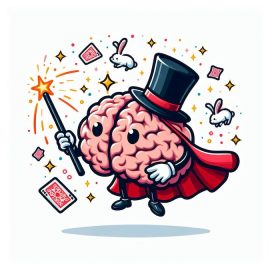

This article is an excerpt from the Shortform summary of "Moonwalking With Einstein" by Joshua Foer. Shortform has the world's best summaries of books you should be reading.
Like this article? Sign up for a free trial here .
What are the best memory strategies? Are there memorization training techniques that can help you learn to memorize lots of information at once?
The best memory strategies are ones that allow you to use your natural memorization strengths for things that are harder to remember. You can use these memory strategies to improve your memory overall, or to help you
Keep reading to find out more about fast memorization techniques, and the best memory strategies.
Memory Strategies That Work
So how can we improve our memory? These top memory strategies and fast memorization techniques can help.
1. Punning
To use punning, change an abstract word into a concrete word by using rhymes or puns. You can also employ alliteration or repetition. For example, if you need to remember the title of the book The Joy of Cooking, you might picture a boy who’s good-looking.
Punning can also be used to memorize word-for-word. For example, mental athletes assign images to words like “and” and “the” and then picture a string of images to remember the exact words. One German mnemonist remembers the word “and” by picturing a circle because the German word for round, “rund,” rhymes with “and.” Punning is one of the top memory strategies.
2. Baker/baker Paradox
The Baker/baker paradox is a phenomenon you can manipulate to help yourself remember names. If you’re shown a picture of a person and told her last name is Baker, you won’t remember “baker” as well as if you’re told she is a baker. This is because “Baker,” as a name, is an abstract concept without much to associate with it. As a profession, however, “baker” is associated with things like flour, the smell of cookies, the heat of an oven, and so on.
To remember people’s names, create an image that combines what they look like with a visual of something that will cue a memory of their name. For example, the name Joshua Foer could be remembered by imaging Joshua (he looks like this) joshing you so hard you break into four pieces.
3. “Method Acting”
Method acting is another one of the memory training techniques. This is a method of memorizing word-for-word that’s similar to method acting. To use this method, break sections of a text into small chunks and assign them emotions rather than images.
4. Chunking
Your working memory can only hold five to nine pieces of information at once, so if you need to remember something like a 16-digit credit card number, it’s a tall order. Chunking is a method of breaking and combining individual things into meaningful groups so that you have fewer things to remember.
For example, if you had to remember the letters ONCEUPONATIME, that’s 13 individual letters, more than your working memory can handle. However, if you group those letters into four words, ONCE UPON A TIME, then you only have to remember four things instead of 13. Chunking is another one of the effective memory training techniques.
5. The Major System
The major system is a method of converting numbers into sounds, then into words, then into images. You can use it to memorize any string of numbers, such as your SSN or phone numbers.
6. The Person-Action-Object (PAO) System
The person-action-object system is a method for remembering the order of numbers or cards. This is one of the commonly used fast memorization techniques used by mnemonists. This method is used primarily by mental athletes who have to memorize hundreds of digits—if you’re just memorizing everyday numbers such as phone numbers, the major system will likely serve your purposes.
Competitive mnemonists are always refining this method and some have even gone beyond creating images for two-digit numbers or single cards, instead coming up with images for every three-digit number or two-card combination.
Now that you know the top memory strategies, you can put them into action. You can learn all of the memory training techniques to have a better memory.

———End of Preview———
Like what you just read? Read the rest of the world's best summary of Joshua Foer's "Moonwalking With Einstein" at Shortform .
Here's what you'll find in our full Moonwalking With Einstein summary :
- The memory techniques that took the author from novice to US memory champion in one year
- The 6 key types of memory we use everyday
- Why memory isn't just genetic, and how you can improve your memory with the right techniques






